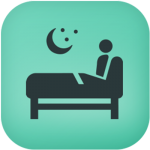Symptoms
WHAT IS IT?
Insomnia is difficulty falling asleep, staying asleep, or waking up too early in the morning. Women with insomnia often feel tired, have low energy, and have trouble concentrating. Their mood may be disturbed, they may have low libido, and may not function well during the day.
To be diagnosed with insomnia, your lack of sleep needs to interfere with daily functioning.
If insomnia happens at least 3 times a week for three or more months, it is considered chronic.
WHAT’S HAPPENING TO MY BODY?
During the perimenopause period estrogen production becomes erratic and then decreases dramatically once a woman stops menstruating. It is thought that these estrogen changes contribute to the increased risk of insomnia during perimenopause. Some women find that they awake when they have night sweats and then have trouble going back to sleep.
WHAT TO EXPECT
Insomnia is a common complaint of women during the menopause transition. Complaints increase as women get closer to menopause.
Sleep problems also increase as we age. Other risk factors for insomnia include: poor sleep habits, depression, anxiety, lack of exercise, obstructive sleep apnea, and some medications.
Treatments that are inappropriate or have not been studied for this symptom are not listed.
Please scroll beyond “References” to access more resources if you are browsing on mobile or tablet
Baglioni C, Bostanova Z, Bacaro V, Benz F, Hertenstein E, Spiegelhalder K, Rücker G, Frase L, Riemann D, Feige B. A Systematic Review and Network Meta-Analysis of Randomized Controlled Trials Evaluating the Evidence Base of Melatonin, Light Exposure, Exercise, and Complementary and Alternative Medicine for Patients with Insomnia Disorder. J Clin Med. 2020 Jun 22;9(6):1949. doi: 10.3390/jcm9061949. PMID: 32580450; PMCID: PMC7356922.
Bolge SC, Balkrishnan R, Kannan H, Seal B, Drake CL. Burden associated with chronic sleep maintenance insomnia characterized by nighttime awakenings among women with menopausal symptoms. Menopause. 2010; 17(1):80–86. doi:10.1097/gme.0b013e3181b4c286. PMID: 19730276.
Ciano C, King TS, Wright RR, Perlis M, Sawyer AM. Longitudinal Study of Insomnia Symptoms Among Women During Perimenopause. J Obstet Gynecol Neonatal Nurs. 2017;46(6):804‐813. doi:10.1016/j.jogn.2017.07.011. PMID: 28886339.
Daley M, Morin CM, LeBlanc M, Grégoire JP, Savard J. The economic burden of insomnia: Direct and indirect costs for individuals with insomnia syndrome, insomnia symptoms, and good sleepers. Sleep. 2009; 32(1):55–64. PMID: 19189779.
McCurry SM, Guthrie KA, Morin CM, Woods NF, Landis CA, Ensrud KE, Larson JC, Joffe H, Cohen LS, Hunt JR, Newton KM, Otte JL, Reed SD, Sternfeld B, Tinker LF, LaCroix AZ. Telephone-Based Cognitive Behavioral Therapy for Insomnia in Perimenopausal and Postmenopausal Women With Vasomotor Symptoms: A MsFLASH Randomized Clinical Trial. JAMA Intern Med. 2016 July 1; 176(7): 913–920. doi:10.1001/jamainternmed.2016.1795. PMID: 27213646.
Reed SD, Newton KM, LaCroix AZ, Grothaus LC, Ehrlich K. Night sweats, sleep disturbance, and depression associated with diminished libido in late menopausal transition and early postmenopause: Baseline data from the Herbal Alternatives for Menopause Trial (HALT). Am J Obstet Gynecol. 2007; 196(6):593. e591–597. doi:10.1016/j.ajog.2007.03.008. PMID: 17547910.
Hartz A, Ross JJ, Noyes R, Williams P. Somatic symptoms and psychological characteristics associated with insomnia in postmenopausal women. Sleep Med. 2013; 14(1):71–78. doi:10.1016/j.sleep.2012.08.003. PMID: 23041035.
Jehan S, Masters-Isarilov A, Salifu I, Zizi F, JeanLouis G, Pandi-Perumal SR, Gupta R, Brzezinski A, McFarlane SI. Sleep Disorders in Postmenopausal Women. J Sleep Disord Ther. 2015 August ; 4(5): . doi:10.4172/2167-0277.1000212. PMID: 26512337.
Morin CM. Combined therapeutics for insomnia: Should our first approach be behavioral or pharmacological?. Sleep Med. 2006; 7(S1):S15–S19. doi:10.1016/j.sleep.2006.03.005. PMID: 16702028.
Morin CM, Vallières A, Guay B, Ivers H, Savard J, Mérette C, Bastien C, Baillargeon L. Cognitive behavioral therapy, singly and combined with medication, for persistent insomnia: a randomized controlled trial. JAMA. 2009; 301(19):2005– 2015. doi:10.1001/jama.2009.682. PMID: 19454639.
Morin CM, Beaulieu-Bonneau S, Ivers H, Vallières A, Guay B, Savard J, Mérette C. Speed and trajectory of changes of insomnia symptoms during acute treatment with cognitive-behavioral therapy, singly and combined with medication. Sleep Med. 2014; 15(6):701–707. doi:10.1016/j.sleep.2014.02.004. PMID: 24831251.
Utian WH. Psychosocial and socioeconomic burden of vasomotor symptoms in menopause: A comprehensive review. Health Qual Life Outcomes. 2005;3:47. Published 2005 Aug 5. doi:10.1186/1477-7525-3-47. PMID: 160835502.
Woods NF, Hohensee C, Carpenter JS, Cohen L, Ensrud K, Freeman EW, Guthrie KA, Joffe H, LaCroix AZ, Otte JL. Symptom clusters among MsFLASH clinical trial participants. Menopause. 2016;23(2):158‐165. doi:10.1097/GME.0000000000000516. PMID: 26506500.
Woods N, Mitchell ES. Sleep symptoms during the menopausal transition and early menopause: Observations from the Seattle Midlife Women’s Health Study. Sleep. 2010; 33(4):539–549. doi:10.1093/sleep/33.4.539.PMID: 20394324.
Woods NF, Mitchell ES. Symptom interference with work and relationships during the menopausal transition and early postmenopause: Observations from the Seattle Midlife Women’s Health Study. Menopause. 2011; 18(6):654–661. doi:10.1097/gme.0b013e318205bd76. PMID: 21317821.
Xu Q, Lang CP. Examining the relationship between subjective sleep disturbacne and menopause: A systematic review and meta-analysis. Menopause. 2014; 21(12):1301–1318. doi:10.1097/GME.0000000000000240. PMID: 24800878.
Last reviewed July 2021



